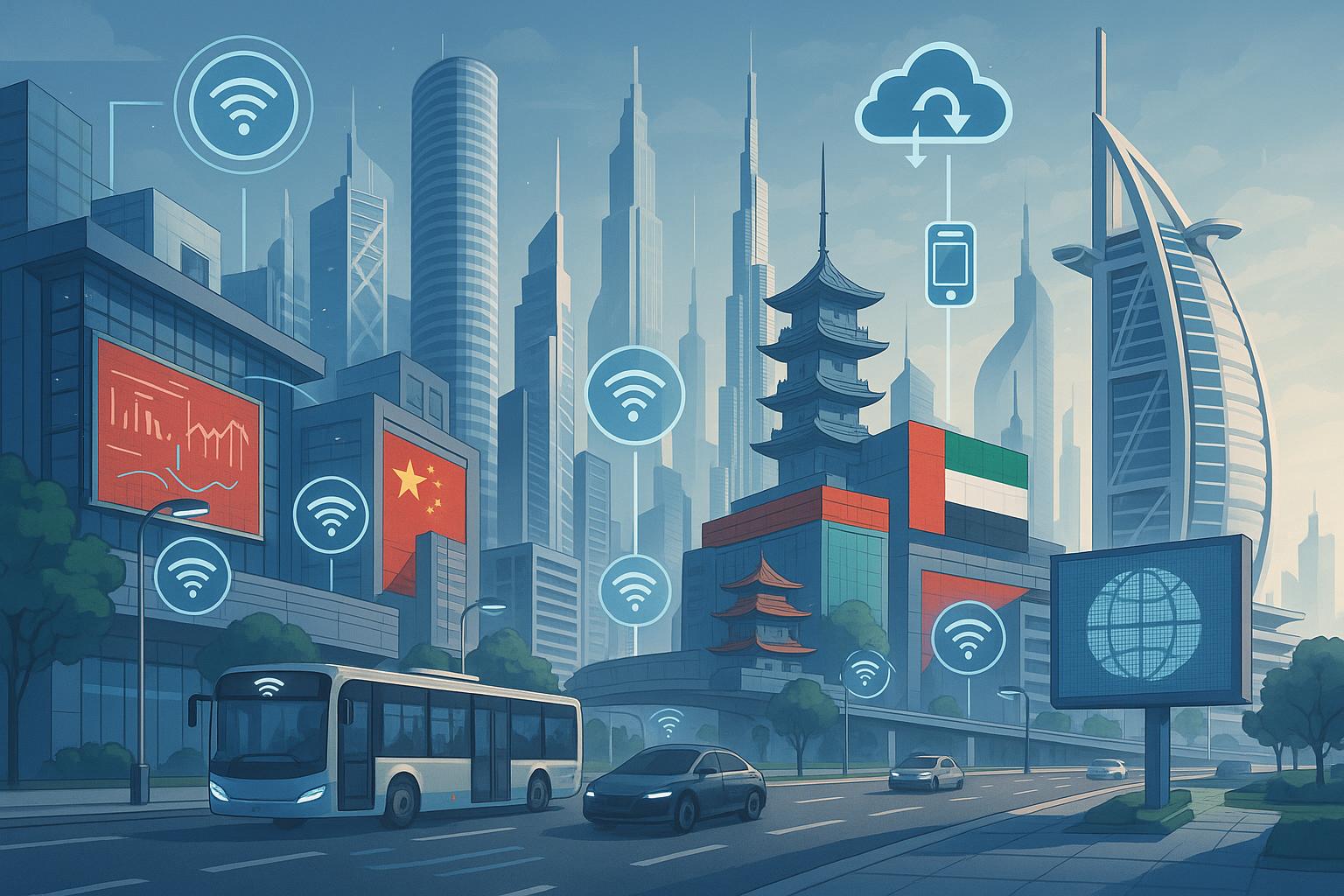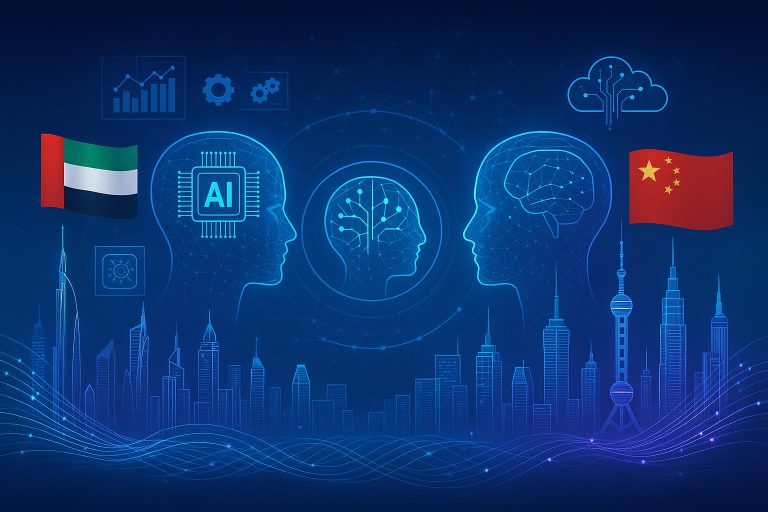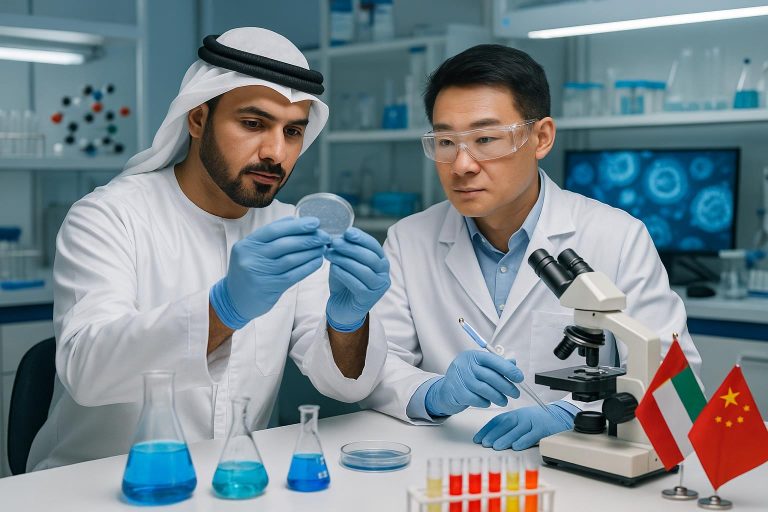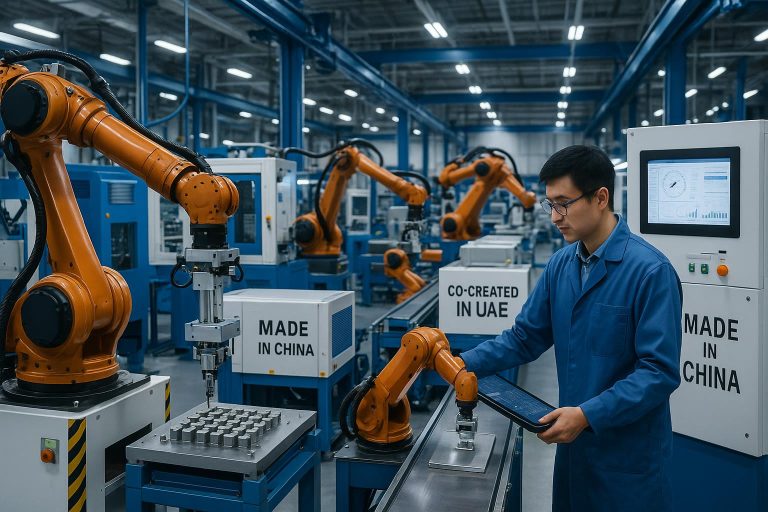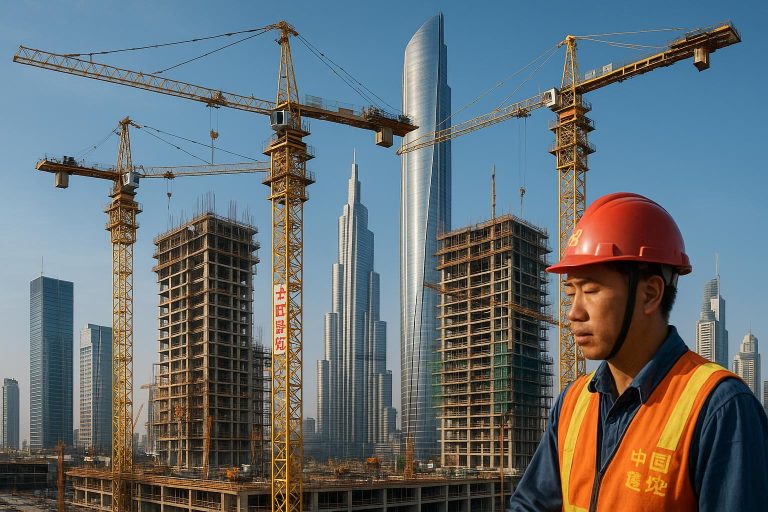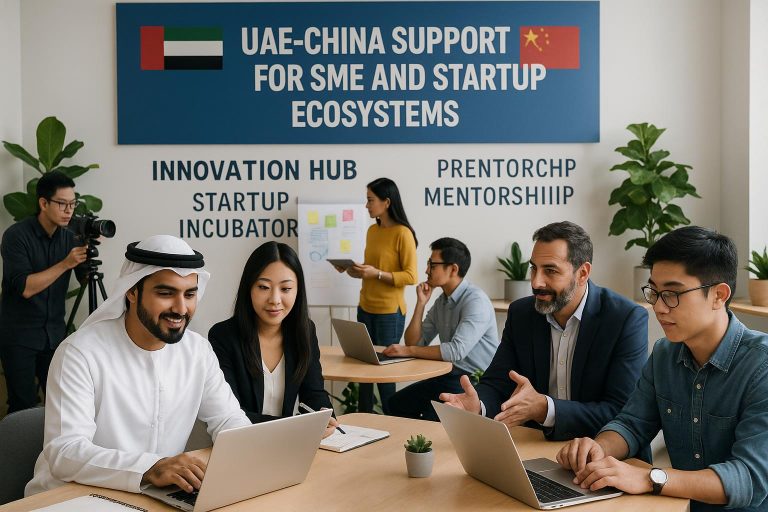Blueprint for Tomorrow: How Chinese Technology is Powering the UAE’s Smart City and Digital Transformation Agenda
Executive Summary
The United Arab Emirates (UAE) and China have forged a robust and rapidly expanding comprehensive strategic partnership, exemplified by a bilateral trade volume that reached a record $101.8 billion in 2024. This remarkable growth underscores the deep economic ties and mutual strategic interests between the two nations. At the heart of this evolving relationship is the pivotal role of Chinese technology in accelerating the UAE’s ambitious smart city initiatives and comprehensive digital transformation agenda. From advanced AI solutions and renewable energy projects to sophisticated logistics infrastructure and cutting-edge agricultural technologies, Chinese enterprises are actively contributing to the UAE’s vision for a diversified, knowledge-based economy. This article explores the multifaceted dimensions of this collaboration, highlighting key sectors such as technology, infrastructure, and clean energy, while also examining the strategic opportunities and critical considerations that define this dynamic partnership. The synergy between China’s technological prowess and the UAE’s forward-looking development goals is creating a powerful blueprint for future innovation and sustainable growth across the region.
Introduction
The United Arab Emirates (UAE) and the People’s Republic of China are charting a new course in international cooperation, marked by a burgeoning partnership that transcends traditional economic exchanges. This relationship, elevated to a comprehensive strategic partnership in 2018, has seen unprecedented growth, with bilateral trade soaring to a record $101.8 billion in 2024—an astonishing 800-fold increase since 1984. As the UAE solidifies its position as China’s largest export market in the Middle East and its second-largest trading partner in the region, and China remains the UAE’s foremost trading partner, the depth and breadth of their collaboration are undeniable. This article delves into the transformative impact of Chinese technology on the UAE’s ambitious smart city initiatives and its overarching digital transformation agenda. It aims to provide a comprehensive analysis of how Chinese technological advancements, investments, and expertise are not only facilitating the UAE’s vision for a future-ready, diversified economy but also shaping a new paradigm for bilateral cooperation in the 21st century. We will explore the key sectors of engagement, the strategic drivers propelling this partnership, the challenges that must be navigated, and offer forward-looking recommendations for sustained growth.
The Current Landscape of Bilateral Cooperation
The relationship between the UAE and China has evolved into a comprehensive strategic partnership, characterized by robust economic ties and deepening collaboration across a multitude of sectors. This partnership, formally established in 2018, has fostered an environment conducive to significant investment and trade flows. Economically, the figures are compelling: bilateral trade surged to an unprecedented $101.8 billion in 2024, marking an astonishing 800-fold increase since 1984. This makes the UAE China’s largest export market in the Middle East and its second-largest trading partner in the region, while China consistently holds its position as the UAE’s largest trading partner. The presence of over 15,000 Chinese firms operating within the UAE underscores the vibrant commercial activity and mutual trust. Furthermore, UAE investments in China have seen remarkable growth, reaching $4.5 billion by the end of 2023, a 96% increase from the previous year, demonstrating a reciprocal commitment to economic integration.
Beyond trade, the strategic framework of this partnership is reinforced by regular high-level diplomatic engagements and the active UAE-China Investment and Economic Cooperation Working Group. These mechanisms facilitate policy coordination and streamline investment processes, particularly within the context of China’s Belt and Road Initiative (BRI), which has seen $3.1 billion in projects in the UAE. The geographic focus areas, with Abu Dhabi as a primary investment hub and Dubai playing a crucial role in trade facilitation, further highlight the strategic alignment.
Key cooperation sectors are diverse and strategically aligned with both nations’ development agendas. In Energy & Clean Energy, collaborations include solar and wind power investments, exemplified by the Masdar-China Silk Road Fund MoU for renewable energy projects. Infrastructure & Logistics have seen major projects like the COSCO terminal at Khalifa Port and the China-UAE Industrial Capacity Zone, positioning the UAE as China’s gateway to the Gulf. Technology & AI are central, with numerous cooperation agreements and digital transformation initiatives. The Trade & Free Zones sector benefits from partnerships between JAFZA and Chinese free trade zones, as well as DP World collaborations, enhancing the UAE’s role as a global logistics and re-export hub.
Emerging sectors further diversify this landscape. Healthcare & Pharmaceuticals have seen significant moves, such as Mubadala’s acquisition of UCB Pharma’s mature business in China, alongside partnerships in medical technology and pharmaceutical development. Agriculture & Food Security initiatives, like the $33 million smart agricultural project between Silal and China’s Shouguang Vegetable Group, focus on hydroponics and modern farming. In Aviation & Transportation, Emirates and Air China have signed MoUs for enhanced partnerships, and a $1 billion deal for 350 flying taxis signals future-forward collaboration. Logistics & Supply Chain are bolstered by JINGDONG Property’s Middle East logistics hub in Dubai and JD.com’s smart supply chain technologies. Finally, Financial Services & Fintech are advancing through cross-border payment cooperation between China’s CIPS and the UAE central bank, and fintech partnerships in Abu Dhabi, fostering greater financial connectivity across the MENA region.
Opportunities and Strategic Growth Drivers
The convergence of China’s technological prowess and the UAE’s ambitious vision for smart cities and digital transformation presents a wealth of opportunities and strategic growth drivers. The UAE’s proactive approach to economic diversification, coupled with its strategic geographic location, makes it an ideal partner for Chinese enterprises seeking to expand their global footprint, particularly within the Middle East and Africa. Conversely, China’s advanced capabilities in areas like Artificial Intelligence (AI), 5G, renewable energy, and smart infrastructure are precisely what the UAE needs to realize its future-oriented development goals.
One significant driver is the Digital Transformation Agenda of the UAE. Initiatives like Digital Dubai and the broader national AI strategy are actively seeking cutting-edge solutions. Chinese technology companies, with their extensive experience in developing and deploying large-scale digital infrastructure and AI applications, are well-positioned to contribute. The $5 billion UAE-China partnership for AI, renewable energy, and infrastructure underscores this commitment. Companies like G42, strategically positioned between US and China markets, exemplify the UAE’s intent to leverage global technological advancements for local innovation. Shenzhen, a hub of Chinese technological innovation, is a key reference point for Digital Dubai’s exploration of AI and smart city technologies.
Smart City Development is another critical area. The UAE’s vision for sustainable, technologically advanced urban centers aligns perfectly with China’s expertise in smart city planning and implementation. This includes everything from intelligent transportation systems and smart grids to advanced surveillance and data analytics platforms. The development of the China-UAE Industrial Capacity Zone and the COSCO terminal at Khalifa Port are foundational elements, creating integrated logistics and industrial ecosystems that are inherently ‘smart’ in their design and operation, leveraging automation and digital management.
Clean Energy and Sustainable Development represent a substantial growth avenue. With China being a global leader in renewable energy technologies, its collaboration with the UAE, a nation committed to diversifying its energy mix, is highly synergistic. The Masdar-China Silk Road Fund MoU for renewable energy projects in BRI countries highlights a shared commitment to sustainable development. Chinese investments in solar and wind power projects within the UAE are not only contributing to the nation’s energy security but also transferring valuable expertise and technology.
Furthermore, the expansion into New Economy Sectors is a key strategic driver. The focus on entrepreneurship, tourism, and aviation, as evidenced by recent MoUs and high-level visits, indicates a broadening scope of cooperation. The $1 billion deal for 350 flying taxis (eVTOL aircraft) between the UAE and China is a testament to the forward-thinking nature of this partnership, pushing the boundaries of urban mobility. Similarly, the agricultural sector is being revolutionized through Chinese technology, with projects like Silal and China’s Shouguang Vegetable Group’s $33 million smart agricultural initiative, focusing on hydroponics and modern farming techniques, enhancing the UAE’s food security.
Finally, the Logistics and Supply Chain sector continues to be a cornerstone. The establishment of JINGDONG Property’s first Middle East logistics hub in Dubai and JD.com’s implementation of smart supply chain technologies further solidify the UAE’s role as a critical logistics hub for China-Middle East trade. These developments not only optimize trade routes but also integrate advanced digital solutions for greater efficiency and resilience, directly contributing to the UAE’s smart economy ambitions.
Challenges and Critical Considerations
While the UAE-China partnership presents immense opportunities, it is imperative to acknowledge and critically consider potential challenges to ensure the long-term sustainability and mutual benefit of this collaboration. A balanced perspective requires addressing areas that demand careful navigation and strategic foresight.
One significant consideration revolves around geopolitical dynamics and global perceptions. As both the UAE and China expand their global influence, their deepening ties are observed by other major international players. The UAE’s strategic positioning, balancing relationships with various global powers, necessitates careful diplomacy to avoid being perceived as overly reliant on any single nation. This is particularly relevant in the technology sector, where concerns about data security, intellectual property, and technological standards can arise from different geopolitical alignments. The strategic positioning of companies like G42, navigating between US and China markets, exemplifies this delicate balance.
Another critical aspect is the potential for technological dependence and diversification. While Chinese technology offers advanced and often cost-effective solutions, an over-reliance on a single source for critical infrastructure and digital transformation components could pose long-term risks. The UAE’s strategy should ideally involve diversifying its technology partners to foster competition, ensure resilience, and maintain strategic autonomy in its digital future. This involves careful evaluation of vendor lock-in risks and ensuring interoperability with global standards.
Cultural integration and business practices also present nuanced challenges. Despite the growing presence of over 15,000 Chinese firms in the UAE, differences in business culture, legal frameworks, and communication styles can lead to misunderstandings or inefficiencies if not proactively managed. Effective cross-cultural training, clear contractual agreements, and robust dispute resolution mechanisms are essential to foster a harmonious and productive working environment.
Furthermore, the rapid pace of technological adoption and the scale of Chinese investments necessitate robust regulatory frameworks and governance. Ensuring that smart city technologies, AI applications, and digital infrastructure projects adhere to the UAE’s data privacy laws, ethical AI guidelines, and cybersecurity standards is paramount. This requires continuous dialogue and collaboration between regulatory bodies in both nations to align standards and address emerging challenges in areas like data governance and digital sovereignty.
Finally, while the partnership is overwhelmingly positive, maintaining a critical analytical perspective means continuously assessing the value proposition of each collaboration. This includes evaluating the long-term economic benefits, the transfer of knowledge and skills to the local workforce, and the alignment of projects with the UAE’s broader national development goals. A proactive approach to these considerations will strengthen the partnership, ensuring it remains mutually beneficial and resilient against future uncertainties.
Case Study Spotlight: Smart Agriculture for Food Security
An exemplary illustration of Chinese technology directly contributing to the UAE’s smart city and digital transformation agenda can be found in the agricultural sector. The partnership between the UAE’s Silal and China’s Shouguang Vegetable Group (SVG) for a $33 million smart agricultural project in Al Ain stands as a testament to this collaboration. This initiative focuses on advanced agricultural technologies such as hydroponics, organic farming, and modern cultivation techniques, directly addressing the UAE’s food security objectives, a critical component of any sustainable smart city.
China’s SVG is investing over AED 120 million (approximately $32.7 million) to develop a 100,000m² Agritech facility. This facility will leverage cutting-edge Chinese agricultural technology to produce fresh, high-quality produce locally, significantly reducing reliance on imports. The project not only introduces advanced farming methods but also integrates digital management systems for optimized resource utilization, climate control, and yield prediction, embodying the principles of digital transformation within a vital industry. This case study highlights how Chinese technological expertise is being deployed to build resilient, smart, and sustainable urban ecosystems in the UAE, moving beyond traditional sectors to impact fundamental aspects of urban living.
Future Outlook and Strategic Recommendations
The future trajectory of the UAE-China comprehensive strategic partnership appears exceptionally promising, particularly as both nations continue to prioritize innovation, digital transformation, and sustainable development. The synergy between China’s technological advancements and the UAE’s visionary leadership is poised to unlock new frontiers of cooperation, further solidifying the UAE’s position as a regional hub for technology and innovation.
The Future Outlook is characterized by several key trends. Continued expansion in Artificial Intelligence and Digital Transformation will see deeper integration of Chinese AI solutions into the UAE’s smart city infrastructure, public services, and industrial sectors. The $5 billion partnership for AI, renewable energy, and infrastructure is a clear indicator of this commitment. We can anticipate more collaborations akin to Digital Dubai’s exploration of AI and smart city technologies in Shenzhen, fostering a continuous exchange of knowledge and best practices. The rapid adoption of 5G technology and the development of next-generation digital platforms will further accelerate this transformation.
In Clean Energy and Sustainability, the partnership is expected to deepen, with increased Chinese investment and technology transfer in solar, wind, and potentially hydrogen energy projects. The Masdar-China Silk Road Fund MoU sets a precedent for joint ventures in renewable energy across the BRI countries, positioning the UAE as a key partner in global energy transition efforts. This will not only contribute to the UAE’s Net Zero 2050 strategic initiative but also create new economic opportunities.
Advanced Mobility and Logistics will also see significant growth. The $1 billion deal for 350 flying taxis (eVTOL aircraft) between the UAE and China is a testament to the forward-thinking nature of this partnership, pushing the boundaries of urban mobility. Furthermore, the expansion of logistics hubs by Chinese giants like JINGDONG Property and the implementation of smart supply chain technologies by JD.com will reinforce the UAE’s role as a pivotal global trade and logistics nexus, leveraging digital platforms for enhanced efficiency and connectivity.
To maximize these opportunities, the following Strategic Recommendations are proposed:
- Foster Innovation Ecosystems: The UAE should continue to attract Chinese R&D centers and tech startups by offering competitive incentives, robust intellectual property protection, and access to a skilled workforce. Joint innovation labs and incubators, particularly in AI, blockchain, and sustainable technologies, would accelerate co-creation and knowledge transfer.
- Strengthen Regulatory Alignment: Establish a joint working group focused on harmonizing regulatory frameworks for emerging technologies, including data governance, cybersecurity, and ethical AI. This would create a more predictable and secure environment for technological collaboration and investment.
- Invest in Human Capital Development: Develop specialized training programs and educational exchanges focused on Chinese technological advancements. This would equip the UAE workforce with the necessary skills to manage and innovate with Chinese technologies, ensuring long-term sustainability and local value creation.
- Invest in Human Capital Development: Develop specialized training programs and educational exchanges focused on Chinese technological advancements. This would equip the UAE workforce with the necessary skills to manage and innovate with Chinese technologies, ensuring long-term sustainability and local value creation.
- Diversify and Localize Supply Chains: While leveraging Chinese technology, the UAE should strategically work towards localizing key components of its digital infrastructure and smart city solutions. This would enhance resilience, reduce dependence, and foster a local high-tech manufacturing base.
Promote Cross-Cultural Understanding: Implement initiatives that enhance cultural understanding and facilitate smoother business interactions between Emirati and Chinese enterprises. This includes language training, cultural awareness programs, and platforms for regular dialogue to bridge communication gaps and build stronger interpersonal relationships.
By proactively addressing these areas, the UAE and China can ensure their partnership continues to be a powerful engine for mutual growth, innovation, and the realization of a truly smart and digitally transformed future.
Conclusion
The strategic partnership between the UAE and China has evolved into a dynamic force, driving innovation and economic growth across multiple sectors. The record-breaking bilateral trade and significant mutual investments underscore a relationship built on shared visions for prosperity and technological advancement. Chinese technology, ranging from AI and smart city solutions to renewable energy and advanced logistics, is undeniably a powerful catalyst in the UAE’s pursuit of a diversified, knowledge-based economy and its ambitious smart city agenda. While opportunities abound, a critical and analytical perspective reveals the necessity for careful navigation of geopolitical complexities, fostering technological diversification, and strengthening regulatory frameworks. By embracing strategic recommendations focused on innovation ecosystems, regulatory alignment, human capital development, localized supply chains, and cross-cultural understanding, both nations can ensure the continued resilience and mutual benefit of their collaboration. This partnership is not merely transactional; it is a blueprint for tomorrow, demonstrating how strategic alliances can power transformative change and build a future defined by shared progress and technological leadership.
References
[1] All statistics and research findings cited in this article are based on the provided “UAE-China Bilateral Investment Research Findings” document, which details key statistics, strategic partnership frameworks, cooperation sectors, and recent developments (2024-2025).

